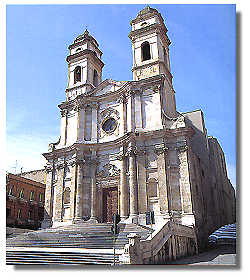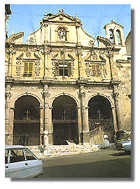
Best viewed from the Bastione di Santa Croce above, the Stampace
neighborhood looks like a sea of low and modest houses marked by time. The higher
part of the area, which is also the older and more interesting part, is located directly
below the overlook with narrow streets climbing towards the hill. Separated by Via
Azuni, the lower part of Stampace descends to the sea.
Monuments:
The predominantly residential area is punctuated by other types of architecture,
such as the church of S.Anna, with its large entrance stairway, S. Michele, a church
that is richly Baroque in its architecture and decoration, or the S.Giovanni di Dio
Hospital. The smaller churches, S.Restituta and S.Efisio, contrasting the monumentality
of the former buildings, are imbued with tales of persecution and martyrdom. Such
19th century constructions as the Carlo Alberto Military Barracks, the prison, and,
further along, the small early medieval church of Ss. Lorenzo e Pancrazio are located in
Viale Buoncammino. The area is home to some of the island's most important archaeological
sites. The Amphitheater (2nd century A.D.) and the aristocratic Tigellio Villa bear
witness to Roman expansion into the western part of the city. Near the S.Avendrace
neighborhood, this presence is confirmed by the Tuvixeddu necropolis with its Phoenician-Punic
origins (a cemetery later utilized by the Romans), and the monumental Grotta della vipera
(Serpent's Cave), a 1st century tomb.
Museums:
In Via Porcell, The University's Department of Anthropological Sciences houses the
Museum of Anthropology and Ethnography, with traditional Sardinian costumes and objects.
Shopping and points of interest:
All kinds of lace items fill the shelves in a shop that is almost one hundred years
old in Piazza Yenne, while the best Sardinian pastries appear in nearby shop windows.
At the foot of the S.Chiara steps, there is a small market and, facing that, a very
well stocked wine store. A jeweler noted for his made-to-order items, shops selling
used clothing, frames, and small collectibles are located in Via Azuni. Larger antiques
(furniture, jewels, and objects) can be found in Corso Vittorio Emanuele. A century-old
hat store in Via Sassari still maintains its original furnishings and accessories.

Eating and drinking:
A refined restaurant is located in Via Sassari; Lalique and Gallé glass decoration
adds to its luxurious atmosphere. A private club in the same street exhibits antique
shoes. "Trattorie", pizzerias, and bars are located throughout the area.
Culture:
The Roman Amphitheater is often used during the summer for outdoor opera and dance
performances. The tiny Teatro dell'Arco, near the arch at the foot of the hill leading
to the Hospital, hosts contemporary theatrical performances and acting workshops.
The neighborhood's religious vocation emerges during the most spectacular manifestation
on the island, the May 1st Procession. Rooted in the legendary story of the flagellation
and death of Saint Efisio, the parade starts in front of the church of the same name in the heart of Stampace.
Promenades and open spaces:
Viale Buoncammino, boundary between Stampace and Castello, is one of Cagliari's loveliest
promenades. Its terraces overlook the expanse of city and surrounding countryside.
With its rare collection of trees, the Botanical Gardens makes a pleasant stop during a visit to this area.
|







